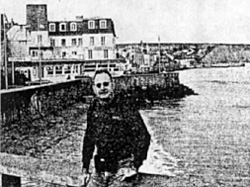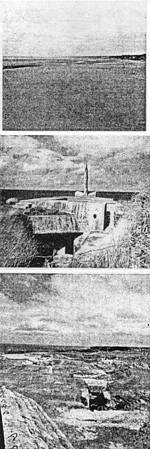 They say opportunity only knocks once. And
so if was during a recent trip to Europe when the
itinerary included a trip to France. The choices
were a trip to Paris, or a tour of the Normandy
countryside. Let's see, a six hour bits ride and two
hours sight seeing or a day trip to the Holy Grail Of
WWII, Omaha Beach. For this history buff the
decision took all of two seconds.
They say opportunity only knocks once. And
so if was during a recent trip to Europe when the
itinerary included a trip to France. The choices
were a trip to Paris, or a tour of the Normandy
countryside. Let's see, a six hour bits ride and two
hours sight seeing or a day trip to the Holy Grail Of
WWII, Omaha Beach. For this history buff the
decision took all of two seconds.
Author at the Restaurant de la Marine
Preparation
The trip included massive amounts of research. I made several trips to the, librury, mostly my own. Maps were high on the list. The internet is a wonderful place however virtual reality will never replace the real thing. I even had an opportunity to discuss the trip with it personal friend of the family who is a French national. Her extensive collections of coffee table books on the French Countryside was instrumental in preparing myself for the photographic portion of the trip.
Marlene knew that I would begin my journey, in a small town on the coast named Arromanches. This town was host to millions of allied servicemen coming ashore during and after the Normandy landings. They had the honor of being the terminus of the famous Mulberry portable harbors. It seems the D-Day planners in an amazing bit of foresight decided to literallY build two portable harbors, tow them to Normandy and construct them under combat conditions. By a stroke of fate the weather wrecked the bridge constructed in the American Sector and spared the one in Arromanches, thus assuring their place in History as the location where many soldiers would take their first steps into liberated Europe.
At Marlene's direction I looked for the Restaurant De La Marine, a noted attraction in Arromanches. The restaurant was not open, however it was great to be able to find a landmark recommended from half a world away.
There is a museum at Arromanches dedicated to the Mulberries and the Allied Soldiers who liberated Europe. British and Canadian artifacts dominate the collection. As the port was constructed in their section I am sure this militaria was more available. Never the less the entire collection was accurate. unique and well preserved. There were dioramas, a small-scale battlefield reconstruction, which was synchronized with a light show and lecture.
The museum has a small theatre that re-played a 15-minute movie regarding the landings and the role of the Mulberries. Most of the clips were from the Movietone news reels of the day.
There was a delay in viewing while the foreign visitors received headsets that would translate the movie. The movie was in English. I wondered if the German version of the narrative was any difjerent than the one I heard. Overall the tone of the information was non-sensational. I kept waiting for one "we kicked their ass" comment but none occurred. The gift shop was also "worth the visit."
 Soon it was back in the bus for a trip to The
American Cemetery at Normandy. The tour guide
mentioned that the property was actually owned by
the United States. This cemetery was featured in
the opening scenes of the movie, "Saving Private
Ryan." The clip shows an elderly veteran, Private
Jack Ryan, moving along the guide path and into the
graveyard to locate the burial site of his lost
Captain, the Tom Hanks figure. It is a deeply
moving scene, which sets the stage for a flashback
that is the movie.
Soon it was back in the bus for a trip to The
American Cemetery at Normandy. The tour guide
mentioned that the property was actually owned by
the United States. This cemetery was featured in
the opening scenes of the movie, "Saving Private
Ryan." The clip shows an elderly veteran, Private
Jack Ryan, moving along the guide path and into the
graveyard to locate the burial site of his lost
Captain, the Tom Hanks figure. It is a deeply
moving scene, which sets the stage for a flashback
that is the movie.
I felt equally moved passing among the neat rows of Crosses and Star of David burial markets. One cannot help but be impressed with the sheer number of graves and the precision with which they are placed row upon row in perfect order planted in an evenly colored green carpet of impeccably manicured grass. While the number of gravesites seems to overwhelm a visitor it must be remembered that it only represents 39% of those eligible to be buried there. It seems that 61% of American families opted to have the remains of their loved ones returned to the United States. One empty- headed tourist actually mumbled, "Why would anyone want to be buried here." The young French tour guide answered simply, "It is considered quite an honor".
Among the crosses we located the gravesite of Theodore Roosevelt Jr. He is the son of the "Teddy Roosevelt." He landed on Omaha beach on D-Day, June 6, 1944. When questioned about landing at the wrong beach he uttered the famous words, "We're starting the war from right here." He was later awarded the Medal of Honor for courage under fire organizing and leading American troops through out crucial portions of the landing."
The Roosevelt's are one of only two father and son pairs to ever receive the Medal of Honor. The other pair is Douglas MacArthur (WWII) and his father Arthur (Civil War).
The cemetery seems to have received a considerable amount of attention and resources over the years. They were installing a sprinkler system while we were there. I couldn't believe how green everything was without sprinklers.
Other portions of the grounds had received great care also. There is a visitors facility, which is flanked b y immense gardens and a walled monument, several stories high The circular walls surround a statue erected as a tribute to all the soldiers who risked their lives liberating Europe.
The walls on either side of the statue include giant mosaics illustrating the major European battle campaigns of WWII. All in all this was an impressive and meaningful tribute to the people who made the ultimate sacrifice.
From the heights of the cemetery we could see the beaches in the distance. The view was awe-inspiring even from such a remote location. It would take a quick bus ride to get down to sea level. Standing on Omaha beach one would not get the impression that it was much different than any other beach in the world. Maybe the sand has a more orange tint than most. What must have made it such an attractive target are the same factors that make it such a nice beach, its flat, the sand packs down and it's accessible. What makes it a killer is the high bank just as you get off the beach. Again the Private Ryan film captures this deadly effect well. The cliff offers many vantage points for firing down on anyone trying to get out of the water
When we visited the wind was blowing fairly hard and there were no swimmers. The scene was stark and lonely. Everyone stood around in a somber mood. I had brought two small bottles to scoop some sand as souvenirs for friends, who had made special requests. As soon as I knelt, the light bulb went off in several other visitor's minds and they ran back to the bus for their water bottles. Soon everyone was pouring out liters of water and filling the bottles with sand. And me with only two one ounce bottles of sand and everyone else with two liters. I got no credit for creativity.
There is another very nice monument commemorating the contributions of so many people who fought and died there. There were relatively few bunkers, trenches or other memorabilia on the conflict. Time has swallowed many of the scars. It is difficult to wound sand and the sea had reclaimed most all reminders, This would not be so at our next location.
Pointe Du Hoc
 The guide hurried us back on the bus
for another dash to our last tour location, Pointe
Du Hoc. Here the healing hands of time had not
been so kind. The hard rock cliff of Pointe Du Hoc
showed every crater, every ballet scar and tons of
broken concrete and rusted heavy metal. The site
was a moonscape.
The guide hurried us back on the bus
for another dash to our last tour location, Pointe
Du Hoc. Here the healing hands of time had not
been so kind. The hard rock cliff of Pointe Du Hoc
showed every crater, every ballet scar and tons of
broken concrete and rusted heavy metal. The site
was a moonscape.
Every several feet was another crater. Sometimes the craters overlapped. Most of the bankers were collopsed from either the bombing or the close combat, which occurred when the Rangers scaled the cliffs and attacked what they thought, were heavy siege guns. The telephone poles they found must have looked very convincing to the photo reconnaissance planes. Reports indicate the Rangers suffered 25% casualties making the discovery.
There is a monument to the second Ranger Battalion at the very edge of the cliff of Pointe Du Hoc. It faces the ocean and is in the shape of the Ranger's dagger pointing skyward Here also time has not been kind. The cliff is collapsing under the weight of the rock monument. We were not allowed to approach as the area was roped off.
Other areas were not so well secured. I've climbed in, out or over any other remaining structure, shell hole or pathway. The Europeans have a different philosophy about liability. There were few warning signs, retaining walls or liability waivers to sign. If you fall off the cliff I guess it means you got too close.
At the end of the day we had traveled far and seen much. It was a long bus ride back to the cruise ship, which gave its plenty of time to absorb the meaning of what we had seen. No one slept, no one talked, we were all alone with out thoughts.
Back to Dispatch December 2002 Table of Contents
Back to Dispatch List of Issues
Back to MagWeb Master Magazine List
© Copyright 2002 by HMGS Mid-South
This article appears in MagWeb (Magazine Web) on the Internet World Wide Web. Other military history articles and gaming articles are available at http://www.magweb.com